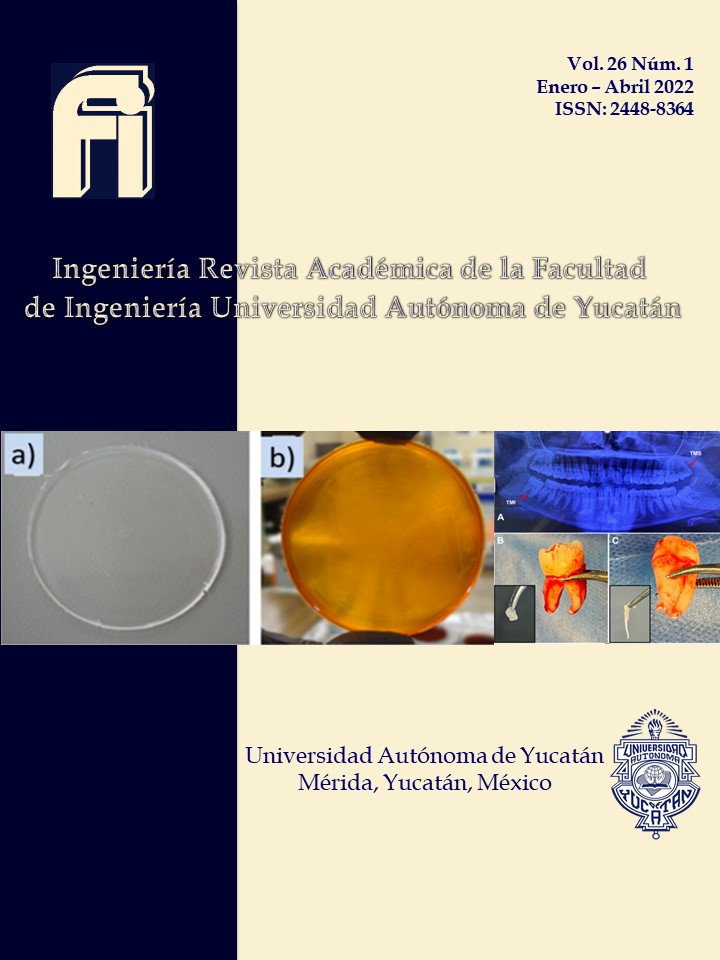Chemical Characterization of Exopolysaccharides Synthesized by a Native Consortium
Abstract
Exopolysaccharides synthesized by halophilic bacteria have important industrial applications. The molecules mainly studied are produced by axenic cultures; however, microbial consortia produce exopolysaccharides more efficiently. Therefore, in this work the chemical characterization of exopolysaccharide synthesized by a microbial consortium obtained from the Laguna Rosada of Uaymitun, a hypersaline water body in Yucatan, Mexico, was carried out. The exopolysaccharide was composed by 61.38% carbohydrates, 1.55% proteins and the remaining 37.07% of unknown compounds. The presence of uronic acids suggest gelling properties. Thin layer chromatographic analysis indicated the possible presence of fucose, that is common in halophilic exopolysaccharides. In addition, electrophoretic analysis suggested the presence of different proteins in the structure.
References
Amjres, H., Béjar, V., Quesada, E., Carranza, D., Abrini, J., Sinquin, C., Ratiskol, J., Colliec-Jouault, S., Llamas, I. (2015). Characterization of haloglycan, an exopolysaccharide produced by Halomonas stenophila HK30. “International Journal of Biological Macromolecules”, 72, 117-124. https://doi.org/10.1016/j.ijbiomac.2014.07.052
Arun, J., Selvakumar, S., Sathishkumar, R., Moovendhan, M., Ananthan, G, Maruthiah, T., Palavesam, A. (2017). In vitro antioxidant activities of an exopolysaccharide from a salt pan bacterium Halolactibacillus miurensis. “Carbohydrate Polymers”, 155, 400-406. https://doi.org/10.1016/j.carbpol.2016.08.085
Bradford, M. (1976). A rapid and sensitive method for the quantitation of microgram quantities of protein utilizing the principle of protein-dye binding. “Analytical Biochemistry”, 72, 248-254. https://doi.org/10.1016/0003-2697(76)90527-3
Bele, A., Khale, A. (2011) An overview on thin layer chromatography. “International Journal of Pharmaceutical Sciences and Research”, 2(2), 256-267. http://dx.doi.org/10.13040/IJPSR.0975-8232.2(2).256-67
Dubois, M., Gilles, K., Hamilton, J., Rebers, P., Smith, F. (1956). Colorimetric method for determination of sugars and related substances. “Analytical Chemistry”, 28(3), 350-356. https://doi.org/10.1021/ac60111a017
Escartin, A. (2017). “Producción de un exopolisacárido por la cepa Leuconostoc mesenteroides ssp mesenteroides BL-UV04 en un medio de cultivo enriquecido con pilomcillo mediante un sistema en lote y lote alimentado”. Tesis de maestría, Universidad Veracruzana, Veracruz, México. https://www.uv.mx/mca/files/2018/01/Escartin-Torres-Alejandra.pdf
Freitas, F., Alves, V., Reis, M. (2011). Advances in bacterial exopolysaccharides: from production to biotechnological applications. “Trends in Biotechnology”, 29(8), 388-398.
Freitas, F., Torres, C., Reis, M. (2017). Engineering aspects of microbial exopolysaccharide production. “Bioresource Technology”, 245, 1674-1683. https://doi.org/10.1016/j.tibtech.2011.03.008
González, A. (2011). “Caracterización genómica y funcional de consorcios microbianos procedentes de una laguna costera”. Tesis de posgrado institucional, Universidad Autónoma de Yucatán, Yucatán, México.
He, F. (2011). Coomassie Blue Staining. “Bio-protocol”, Bio101: e78. https://bio-protocol.org/bio101/e78
He, F. (2011). Laemmli-SDS-PAGE. “Bio-protocol”, Bio101: e80. https://bio-protocol.org/bio101/e80
Kant, S., Kant, R., Choi, Y., Kan, E., Kim, Y., Yang, Y. (2018). Biotechnological potential of microbial consortia and future perspectives. “Critical Reviews in Biotechnology”, 38(8), 1209-1229. https://doi.org/10.1080/07388551.2018.1471445
Laemmli, U. K. (1970). Cleavage of structural proteins during the assembly of the head of bacteriophage T4. “Nature”, 227(5259), 680-685. https://doi.org/10.1038/227680a0
Mancilla-Margalli, N., López, M. (2006). Water-soluble carbohydrates and fructan structure patterns from agave and dasylirion species. “Journal of Agricultural and Food Chemistry”, 54(20), 7832-7839. https://doi.org/10.1021/jf060354v
Mollakhalili, N., Mohammadifar, M. (2015). Microbial exopolysaccharide: A review of their function and application in food sciencie. “Journal of Food Quality and Hazards Control”, 2, 112-117. https://jfqhc.ssu.ac.ir/browse.php?a_code=A-10-1-114&slc_lang=en&sid=1
More, T., Yan, S., Tyagi, R. and Surampalli, R. (2015). Biopolymers production by mixed culture and their applications in water and wastewater treatment. “Water Environment Research”, 87(6), 533-546. https://doi.org/10.2175/106143015x14212658614676
Ruiz, L. (2011). “Diseño de un Proceso para la Obtención de una Galleta a partir de Harina de Trigo Enriquecida con Paraíso Blanco (Moringa oleifera) y su Respectiva Evaluación Nutricional”. Tesis de Licenciatura, Universidad de San Carlos de Guatemala, Guatemala, Guatemala. http://biblioteca.usac.edu.gt/tesis/08/08_1210_Q.pdf
Santos, J., León, K., Alcívar, J., Flores, E., Olivares, S. (2016). Cuantificación y caracterización química de exopolisacáridos (EPS) producidos por una cepa de Penicillium sp. aislada de la Antártida. “Revista Científica de Ciencias Naturales y Ambientales”, 10(2), 97-101.
Sran, K., Bisht, B., Mayilraj, S., Choudhury, A. (2019). Structural characterization and antioxidant potential of a novel anionic exopolysaccharide produced by marine Microbacterium aurantiacum FSW-25. “International Journal of Biological Macromolecules”, 131, 343-352. https://doi.org/10.1016/j.ijbiomac.2019.03.016
Taylor, K., Buchanan-Smith, J. (1992). A colorimetric method for the quantitation of uronic acis and a specific assay for galacturonic acid. “Analytical Biochemistry”, 201(1), 190-196. https://doi.org/10.1016/0003-2697(92)90194-c
Wang, J., Salem, D., Sani, R. (2018). Extremophilic exopolysaccharides: a review and new perspectives on engineering strategies and aplications. “Carbohydrate Polymers”, 205, 8-26. https://doi.org/10.1016/j.carbpol.2018.10.011
Wang, K., Li, W., Rui, X., Chen, X., Jiang, M. and Dong, M. (2014). Characterization of a novel exopolysaccharide with antitumor activity from Lactobacillus plantarum 70810. “International Journal of Biological Macromolecules”, 63, 133-139. https://doi.org/10.1016/j.ijbiomac.2013.10.036
Zhang, S., Merino, N., Okamoto, A. and Gedalanga, P. (2018). Interkingdom microbial consortia mechanisms to guide biotechnological applications. “Microbial Biotechnology”, 11(5), 833-847. https://doi.org/10.1111/1751-7915.13300

This work is licensed under a Creative Commons Attribution-NonCommercial 4.0 International License.
Avisos de derechos de autor propuestos por Creative Commons
1. Política propuesta para revistas que ofrecen acceso abierto
Aquellos autores/as que tengan publicaciones con esta revista, aceptan los términos siguientes:
- Los autores/as conservarán sus derechos de autor y garantizarán a la revista el derecho de primera publicación de su obra, el cuál estará simultáneamente sujeto a la Licencia de reconocimiento de Creative Commons que permite a terceros compartir la obra siempre que se indique su autor y su primera publicación esta revista.
- Los autores/as podrán adoptar otros acuerdos de licencia no exclusiva de distribución de la versión de la obra publicada (p. ej.: depositarla en un archivo telemático institucional o publicarla en un volumen monográfico) siempre que se indique la publicación inicial en esta revista.
- Se permite y recomienda a los autores/as difundir su obra a través de Internet (p. ej.: en archivos telemáticos institucionales o en su página web) antes y durante el proceso de envío, lo cual puede producir intercambios interesantes y aumentar las citas de la obra publicada. (Véase El efecto del acceso abierto).

